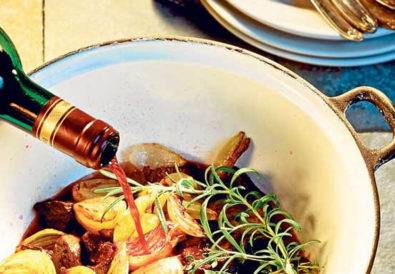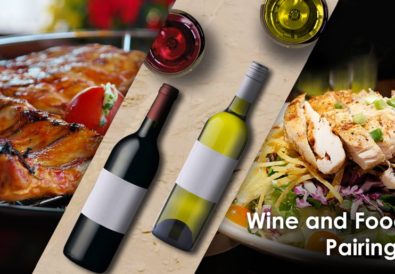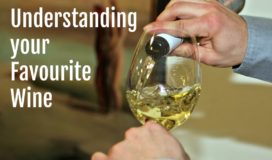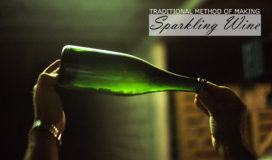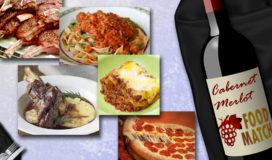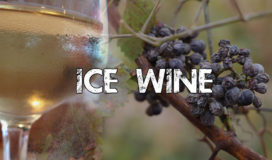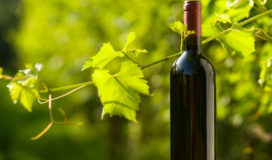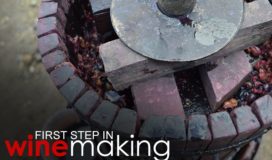
Sauvignon Blanc Infused Roast Turkey
A well-browned turkey, revealing moist and tender meat, flavoured with carrots, onions, celery, assorted fresh herbs, homemade stock, and dry white wine, of course! This recipe is for an unstuffed bird, as cooking the stuffing separately is much safer. The cavity is breeding grounds for bacteria, and the stuffing may soak contaminated juices from it. Separately cooking the stuffing ensures that it is safe to consume, and if you use turkey stock, it will turn out just as flavoursome, if not more! If you like, stuff the bird with cooked stuffing, just prior to serving it, and no-one will ever know!
Ingredients
- 1 Whole turkey – Ensure that the bird is fresh. It should be skin-on, with neck and giblets removed. For more, refer to ‘Note’ section.
- 1 Cup Kosher salt – Substitute with the same weight of table salt, if required. 290gm
- 2 Large carrots – peeled and sliced
- 1 Onion – peeled and sliced
- 1 Celery stalk – leaves discarded and the stalk sliced
- 1/2 Cup Turkey stock (to start with. Keep more handy.) – Prepare using the neck and giblets that were removed. 125ml
- 1/2 Cup Dry white wine – Use Sauvignon Blanc or Pinot Grigio/ Gris 125ml
- 2 Sprigs of thyme
- 1 Sprigs of thyme
- 1/2 Cup butter – Would depend on the size of the turkey used. We suggest you melt ¼ cup/ 60g butter to begin with, and then more, if required. 165gm
- Salt and pepper to taste
Instructions
-
Using your hands, rub the salt on the turkey. Ensure that you don’t miss any area, including the meat under the wings or even the cavity. Transfer it to a large vessel, and pour in the water, enough to cover the bird. Some recipes also suggest adding aromatics such as peppercorns and bay leaves at this stage, but that does little good since the water is not heated (and hence the spices don’t release their flavour in water, in the first place). Refrigerate overnight, allowing the salt to seep in
-
At the time of roasting, drain the turkey, discarding the brine. Rinse and pat dry using paper towels.
-
Mix the melted butter with enough pepper to season it. Brush the meat under the skin with this seasoned butter. This, is one of the secrets for moist meat, particularly the turkey breast. Now nicely brush the outside with the butter.
-
Preheat your oven to 160°C/ 325°F/ gas mark 3. As it heats, place the turkey, breast side down, on a rack in a roasting pan. Stuff the fresh thyme and bay leaf in the bird’s cavity. Scatter the onion, carrot & celery around the bird, on the bottom of the roasting pan. Pour the turkey stock and the wine. Roast the turkey uncovered in the hot oven, basting it very well every 30 minutes with the liquid in the roasting pan. If the pan starts drying out, pour in more stock.
-
If you are using a smaller turkey weighing about 3.5kg, roast it for 2 hours and 45 minutes. If it's a kilogram or two heavier and weighs around 4.5-5.5 kg, roasting time will be 3 hours. Similarly, roast a 6.5kg bird for 3 hours and 45 minutes. A 7kg bird should be roasted for 4 hours while a 8kg turkey should go into the oven for 4 hours and 15 minutes. Regardless of the cooking time, turn the turkey breast side up once two-thirds of the time has been exhausted. This will give it a nice browning. Also, when you turn the bird, brush it with the remaining peppery butter.
-
Irrespective of the cooking time mentioned, you must continue roasting the bird until a meat thermometer inserted in the thickest part of the thigh reads at least 85°C/ 180°F. Then remove the turkey from the oven and let it stand for half an hour before carving. Use the drippings and liquid in the pan to make a gravy to go along.
Recipe Notes
1. Turkeys are available in various sizes. The size/ weight of the turkey you use will affect the cooking time of the preparation. This recipe does not feature a turkey of a certain size for your convenience. Just follow the recommended roasting time and you will be good.
2. Brining the turkey serves two purposes. One, salt permeates the flesh, seasoning it. Secondly, this results in meat that is more moist.
3. We are using multiple techniques here to ensure that the meat remains moist, particularly the turkey breast. (This is because the breast has a tendency to go dry more than any other cut.) Apart from brining the bird to roasting it upside-down, which ensures that all the drippings keep falling on the breast, constantly basting it. The result is meltingly soft goodness!
4. If you carve the turkey immediately after roasting it, the meat will lose a lot of its juices. Allowing it to rest will ensure that it retains them.




